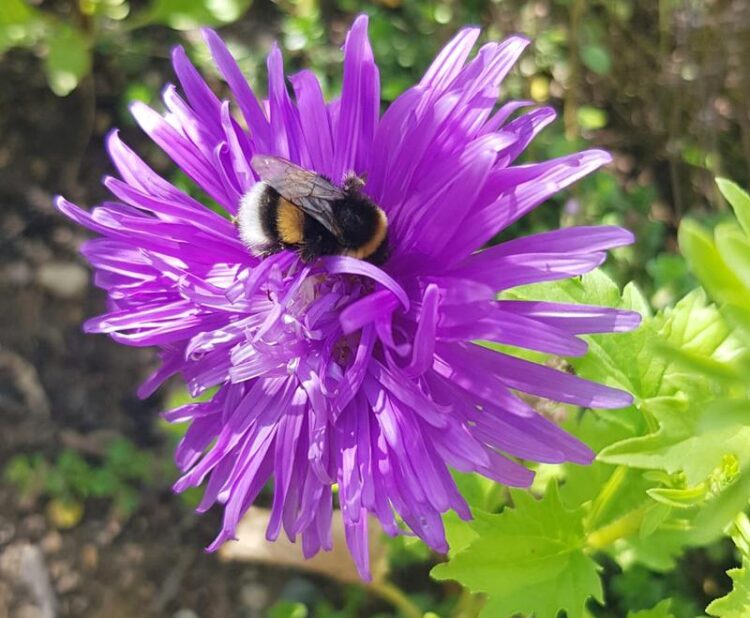Bumblebees Don’t Care about Pesticide Cocktails

During their foraging flights, bumblebees can ingest various pesticides with nectar and pollen. Scientists at the University of Würzburg have investigated the effect on learning behavior and flight activity
(c) Antonia Schuhmann / University of Wuerzburg
In their natural environment, wild bees are exposed to various pesticides that can have a potentially toxic effect. A study by the University of Würzburg has now shown that bumblebees are relatively resistant to these products.
Bumblebees appear to be quite resistant to common pesticides. This is shown by a new study, the results of which have now been published by scientists from Julius-Maximilians-Universität Würzburg (JMU) in the journal Environment International.
The team from the University’s Biocenter divided a bumblebee colony and exposed the animals to individual insecticides and fungicides as well as combinations of these pesticides. The scientists then examined the learning ability and flight activity of the bumblebees treated in this way. No negative effects were found. The study was carried out in cooperation with the University of Bayreuth.
Wild Bees Absorb Many Pesticides
“Save the bees!” This call has been on everyone’s lips in recent years and has drawn attention to the worldwide bee losses. Contrary to popular belief, however, honeybees are not affected by this decline, as they are well cared for by beekeepers. Bee mortality particularly affects wild bees, which have been studied much less intensely than honeybees.
“In nature, bees are not only exposed to individual stressors but usually encounter a variety of factors which can have negative effects on pollinators. The use of pesticides is one of the main causes of insect decline,” says Ricarda Scheiner, explaining the background of the recently published study. Scheiner is Professor for the Neuroethology of Arthropods at the Department of Zoology II at JMU and lead author of the study.
Wild bees including bumblebees ingest many different pesticides on their foraging flights and carry them into the colony via their food. “The ingestion of pesticide mixtures can have effects on behavior that are difficult to predict. Some agents can interact with each other and influence each other’s effects, which can result in an enhanced or weakened effect,” says Antonia Schuhmann, first author of the study and doctoral student with Ricarda Scheiner.
New Method for Researching Pesticide Mixtures
So, what happens when bumblebees ingest a cocktail of pesticides? Does this affect their behavior? The scientists investigated these questions in their experiments. In order to investigate whether pesticide mixtures have an effect on the learning behavior and flight activity of bumblebees, they have developed a new method at the Biocenter of the University of Würzburg.
A bumble bee colony is divided into four “compartments”. “This makes it possible to test individual treatments with insecticides and fungicides as well as mixed treatments on the same colony,” explains Ricarda Scheiner. Thanks to the new method, differences between colonies can be ruled out. In addition, fewer colonies are required per trial.
Two Experiments Show no Effects
The researchers investigated learning behavior and flight activity after treatment with an insecticide, a fungicide and a mixture of the two and compared the results with a control group. To investigate learning behavior, the bumblebees were conditioned to colored dummy flowers in a flight arena. They had to learn to associate a certain flower color with a sugar water reward and then fly to the trained color in a targeted manner. The result: the various pesticide treatments had no effect on the bumblebees’ ability to learn.
Flight activity was investigated using modern RFID technology. Small tags were attached to individual bumble bees, so that each animal had its own ID. Scanners in front of the colony read the ID and stored it, each with a time stamp. Thus the scientists were able to precisely determine the flight activity of each bumblebee. Again, the analysis showed no effects of the pesticides.
The Bumblebee Appears to Be a Robust Wild Bee
“The experiments show that the bumblebee appears to be resilient to chemical stressors such as pesticides,” says Antonia Schuhmann, summarizing the main result of the study. However, it remains unclear how other wild bees would perform in the trials. “The bumblebee benefits from its social lifestyle in the colony, which can buffer toxic effects and ensure the survival of weak individuals,” says Ricarda Scheiner. In addition, the bumblebee differs in body size from many solitary wild bees, which are significantly smaller.
According to the scientists, further experiments are therefore urgently needed to understand the effect of pesticide mixtures on different wild bee species.
Wissenschaftliche Ansprechpartner:
Prof. Dr. Ricarda Scheiner, Chair of Zoology II – Behavioral Physiology and Sociobiology, T: +49 931 31-84745, ricarda.scheiner@uni-wuerzburg.de
Originalpublikation:
Schuhmann, A., Schulte, J., Feldhaar, H., Scheiner, R. (2024). Bumblebees are resilient to neonicotinoid-fungicide combinations. Environment International 186 (108608). https://doi.org/10.1016/j.envint.2024.108608
Media Contact
All latest news from the category: Life Sciences and Chemistry
Articles and reports from the Life Sciences and chemistry area deal with applied and basic research into modern biology, chemistry and human medicine.
Valuable information can be found on a range of life sciences fields including bacteriology, biochemistry, bionics, bioinformatics, biophysics, biotechnology, genetics, geobotany, human biology, marine biology, microbiology, molecular biology, cellular biology, zoology, bioinorganic chemistry, microchemistry and environmental chemistry.
Newest articles

Innovative 3D printed scaffolds offer new hope for bone healing
Researchers at the Institute for Bioengineering of Catalonia have developed novel 3D printed PLA-CaP scaffolds that promote blood vessel formation, ensuring better healing and regeneration of bone tissue. Bone is…

The surprising role of gut infection in Alzheimer’s disease
ASU- and Banner Alzheimer’s Institute-led study implicates link between a common virus and the disease, which travels from the gut to the brain and may be a target for antiviral…

Molecular gardening: New enzymes discovered for protein modification pruning
How deubiquitinases USP53 and USP54 cleave long polyubiquitin chains and how the former is linked to liver disease in children. Deubiquitinases (DUBs) are enzymes used by cells to trim protein…



